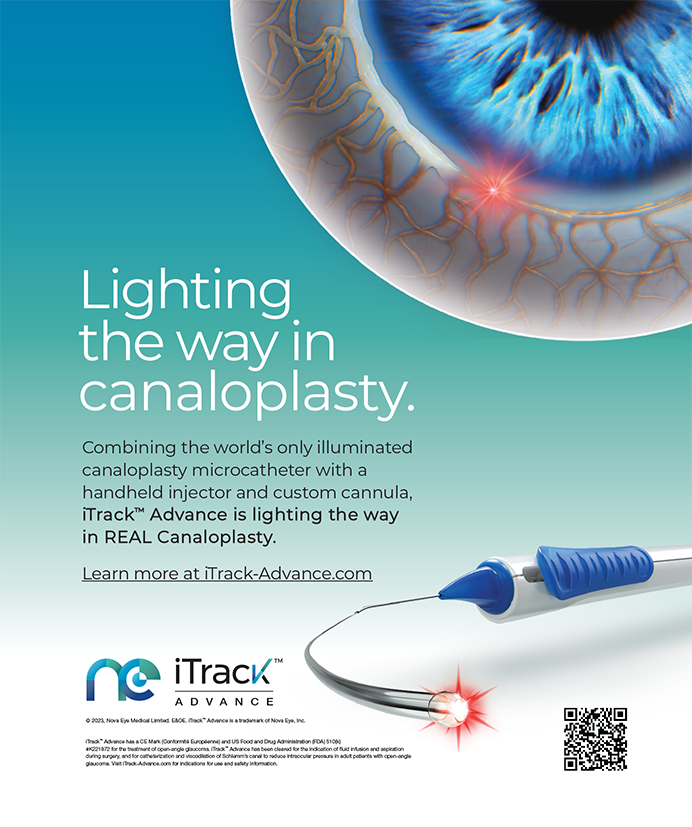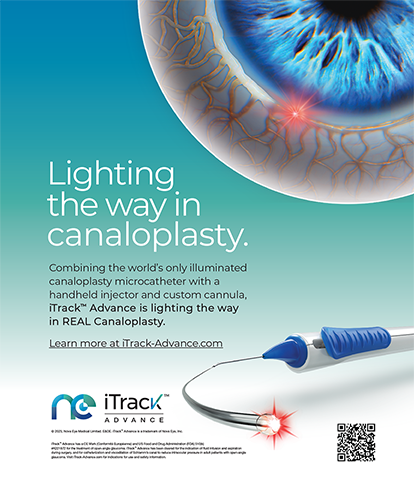Pattern Scanning Laser Trabeculoplasty (PSLT) technology (not available in the United States; Topcon Medical Laser Systems) is a new approach to treating glaucoma via the trabecular meshwork (TM). Pattern scanning laser technology provides a computer-guided treatment method that applies a sequence of patterns onto the TM. Calculated alignment of each pattern ensures that consecutive treatment steps are pieced together around the TM without overlap or excessive gaps.
THE PROCEDURE
The clinician titrates laser power using a single 100-µm spot to achieve light blanching of the TM, with 10-millisecond laser pulses applied to the inferior segment of the eye, where pigmentation is often most densely concentrated. After titration, power is maintained, but the pulse duration is reduced to 5 milliseconds. The pulse energy is thus cut in half, which makes the treatment outcome ophthalmoscopically invisible. Using the inferior segment for titration helps to ensure that the 5-millisecond treatment pulses will be invisible in all segments of the TM.
Physicians can choose to treat half or all of the TM. Treatment is administered in 32 steps for 360º of the TM. The aiming beam automatically rotates. When I treat patients, I rotate the gonio laser contact lens to set the aiming beam on the TM.
After the described steps, treatment is complete.
RESEARCH
PSLT was developed based on a clinical understanding of the nonlethal tissue effects of selective laser trabeculoplasty (SLT), and the clinical outcomes of the two procedures are comparable. Turati and colleagues reported the initial experience with PSLT 532 nm, and the overall IOP reduction rate was 24%, similar to SLT.1 PSLT causes no damage to the TM. Lee and colleagues compared PSLT to argon laser trabeculoplasty in cats and examined morphologic changes in the TM. The investigators found that PSLT caused less thermal damage to the TM than ALT.2 Like SLT, PSLT is theoretically repeatable. The procedure also has similar IOP-lowering effects as SLT.1,3
My colleagues and I conducted a retrospective chart review of 21 patients (24 eyes) with open-angle glaucoma who received SLT or PSLT with the Pascal Streamline 577 (Topcon Medical Laser Systems). All eyes were treated for 360º. The average follow-up period was 11 ±4 months in the PSLT group and 18 ±9 months in the SLT group (P = .10), but there was no statistically significant difference in either group. In the PSLT group, the mean IOP at baseline and 6 months was 21.8 (standard deviation [SD], 5.0) and 14.3 (SD, 3.3) mm Hg, respectively. In the SLT group, the mean IOP at baseline and 6 months was 23.8 (SD, 6.7) and 17.3 (SD, 3.4) mm Hg, respectively. There was no significant difference between PSLT and SLT in terms of the average IOP reduction from baseline (33% and 22%, respectively). We found PSLT to be as effective as SLT at lowering IOP over a 6-month period.4
Although further research is needed to verify the extent and the long-term stability of the IOP reduction, PSLT with a 577-nm wavelength appears to be as effective as SLT at lowering IOP over a 6-month period.
Further information on PSLT is available online at tmlsinc.com.
Miho Nozaki, MD, PhD, is an associate professor in the Department of Ophthalmology and Visual Science at Nagoya City University Graduate School of Medical Sciences in Nagoya, Japan. She acknowledged no financial interest in the products or company mentioned herein. Dr. Nozaki may be reached at miho.nozaki@gmail.com.
- Turati M, Gil-Carrasco F, Morales A, et al. Patterned laser trabeculoplasty. Ophthalmic Surg Lasers Imaging. 2010;41(5):538-545.
- Lee JY, Ha SY, Paik HJ, et al. Morphologic changes in trabecular meshwork after patterned and argon laser trabeculoplasty in cats. Curr Eye Res. 2014;39(9):908-916.
- Kim JM, Cho KJ, Kyung SE, Chang MH. Short-term clinical outcomes of laser trabeculoplasty using a 577-nm wavelength laser. J Korean Ophthalmol Soc. 2014;55(4):563-569.
- Nozaki M. Outcomes of patterned laser trabeculoplasty versus selective laser trabeculoplasty in openangle glaucoma. Poster presented at: ASCRS/ASOA Symposium & Congress; April 25-29, 2014; Boston, MA.


